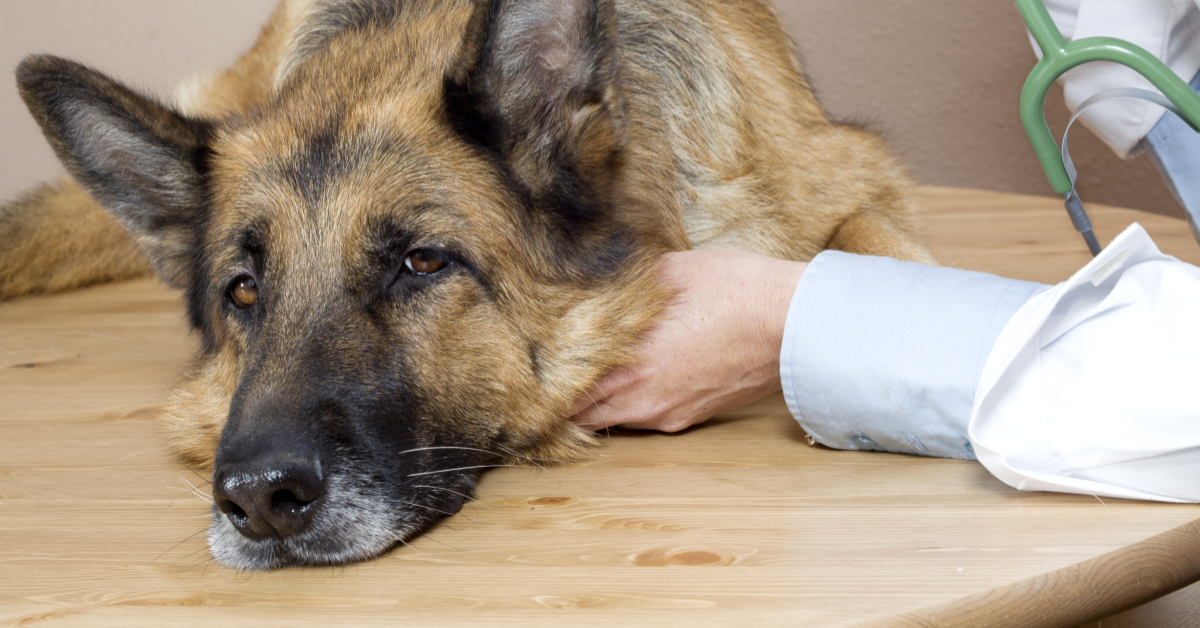Nothing wakes you faster than the sounds of heaving from your fur kid. You rush to be by their side, only to find a large pile of vomit – but this time, it’s yellow?
While one-off yellow dog vomit can be a minor issue, it can also be cause for concern if it persists or is accompanied by other symptoms.
We’re here to help you identify why your might be dog throwing up yellow and what to do about it.
What causes dog vomit?
Dog vomiting is your dog’s body’s natural response to removing harmful substances or relieving discomfort in their tummy. A dog throwing up can occur for various reasons:
- Ingestion of foreign or toxic objects
- Motion sickness
- Gastrointestinal issues
- Parasitic or bacterial Infections
- Stress
- Other underlying health issues
It’s important to note that dog vomit may be a minor issue, like when your dog devours his food too fast and his stomach can’t keep up. However, recurring vomiting, accompanied by other concerning symptoms like lethargy, diarrhea, blood in the vomit, weight loss, or vomiting that lasts for an extended period, is a serious problem.
If this happens to your pet, consult your veterinarian to determine the underlying cause and provide appropriate treatment.
Different types of dog vomit
Dog vomit can come in different colors, textures, and consistencies, and it can contain a range of substances, such as food, bile, foreign material, mucus, or foam.
The appearance of your dog’s vomit can provide clues about the cause of their vomiting. It’s important that pet parents pay close attention to the characteristics of the vomit to help identify potential issues and seek appropriate veterinary care if necessary.
- Food vomit: This type of vomit contains undigested food.
- White foamy vomit: This type of vomit is usually a result of the dog vomiting on an empty stomach. The foam is created when stomach acid and saliva mix.
- Bloody or ‘coffee grounds’ vomit: This type of vomit indicates bleeding in the gastrointestinal tract, and indicates a more serious underlying health issue such as gastric ulcers, ingestion of a toxic substance, or a bleeding tumor.
- Mucus or phlegm vomit: This type of vomit is often seen with respiratory infections, other upper respiratory issues, and some gastrointestinal issues.
- Fecal vomit: This type of vomit is rare, and is usually indicative of a severe digestive tract obstruction that requires immediate veterinary attention.
- Yellow or green vomit: This type of vomit is often a result of bile reflux, which occurs when there is an excess of bile in the stomach. Bile is a digestive system fluid that assists in breaking down fats, and its presence in vomit indicates that the dog’s stomach is empty or hasn’t eaten for a while.
Why do dogs throw up yellow bile?
Dr. Sabrina Kong, DVM, says, “Yellow vomiting in dogs can be either a regular consequence of eating something that upsets their stomach or a sign that something more serious is going on.”
“In most cases, your dog has vomited yellow because they ate something yellow-colored that upset their stomach. In that case, the dog will act normally and show no other discomfort.”
Yellow foam, or bile reflux, is a type of digestive juice produced by the liver that aids digestion. Several different gastrointestinal issues can make bile back up from the stomach. One of the less threatening reasons is an empty stomach. Here are a few other reasons that may contribute to your pup getting sick.
Bilious vomiting syndrome
Bilious vomiting syndrome is when your dog throws up a yellow vomit of stomach acid produced in their liver. Usually, bile helps break down food in the small intestine. In some dogs, if they go too long between meals, they can vomit yellow bile foam. This usually occurs early in the morning, and can often be ameliorated by feeding your dog a small high protein snack right before bed.
Pancreatitis
If your dog eats a meal high in fat, it could cause them to throw up yellow. That’s because too much fat in the food can cause inflammation of the pancreas, leading to vomiting, tummy ache, and diarrhea. Pancreatitis in dogs is a severe condition, very painful, and life-threatening. So, it’s best to keep an eye on what your dog eats and avoid feeding them too many greasy or fatty foods.
Gastrointestinal tract issues
When your dog throws up yellow, it can also mean bile is moving through its system. But, if it’s happening a lot, it could be a sign of something more severe like parasites. Giardia is a common parasite that can cause dogs to throw up yellow bile. This little germ is found in water, food, and soil contaminated by infected animal feces, and is treated with prescription medication.
Other health conditions that cause yellow vomiting can include:
- Cancer
- Gastric ulcers
- Bacterial infections
- Liver disease
- Kidney disease
- Inflammatory bowel disease
- Other GI issues
Intestinal blockage
Your furry friend could also be throwing up yellow due to a GI obstruction. When your pup accidentally ingests foreign objects, it can cause harmful blockage, which may require surgery to remove.
Keep an eye out for any other symptoms and monitor their behavior throughout the day to see if it’s time to take them to the vet. Remember, it’s always better to be safe than sorry about your pup’s health.
Bloat or GDV
If your pet continues to vomit yellow or is dry heaving without bile, it could indicate bloat aka gastric dilatation and volvulus (GDV). This condition causes the stomach to fill with air and twist. It is immediately life-threatening and very painful. Other signs of GDV include a swollen, tight belly, pale gums, racing heart, restlessness, and collapse. If your pup is experiencing any of these symptoms, head to the vet immediately for evaluation. Treatment is surgery.
Allergies
Some dogs can also throw up yellow bile reflux after eating food they’re intolerant or allergic to. Remember, your four-legged friend can develop allergies to their food at any point, even if they’ve been eating the same thing for years. The most common allergies are due to proteins, including chicken, beef, pork, eggs, dairy, and soy.
So, if you notice your pup throwing up after meals, check in with your vet to see if it’s a food allergy or intolerance causing the problem.
Endocrine disorders
Pets with Addison’s disease, diabetes mellitus, or Cushing’s disease may vomit yellow occasionally due to nausea. If your pet has been diagnosed with these diseases and is vomiting, contact your veterinarian immediately for advice.
Toxins
Dogs love exploring and putting their nose in places where it doesn’t belong, which unfortunately means they sometimes ingest toxins that can make them ill.
If your pup accidentally ingests something toxic, it’s time to get help from your veterinarian or the ASPCA Animal Poison Control Center (APCC) hotline at (888)-426-4435.
The symptoms will depend on the toxin type, but yellow vomiting can be a red flag. So, if you think your dog may have ingested something toxic, bring them to your nearest veterinary ER.
What to do if your dog is vomiting yellow bile?
When your pup throws up yellow bile, it may not be a reason to ring the alarm bells. Instead, keep an eye on your pet and ensure they show no other signs or symptoms of health conditions. If it is just one incidence of vomit and then they are fine, then you likely don’t need to do anything. Don’t feed them anything for several hours, and then around dinner time, offer a small amount (about ¼ their normal meal size) of food. If there are multiple episodes of vomiting and/or your dog is acting sick in any way, call your vet.
If you already know your dog has a sensitive stomach, you can try feeding your dog plain chicken and rice for a few days to help settle their stomach. But if the vomiting persists, it’s time to call your vet for backup.
When to see a vet
As a pet parent, you’ll want to know when you should wait it out and when you should visit the vet. If your furry friend has been vomiting for less than 12 hours, seems energetic, and is keeping food down, you may be able monitor your dog at home without going to the vet.
Dr. Sabrina Kong says, “If your dog has vomited bile and is showing other symptoms like diarrhea, lethargy, abdominal pain, weakness, etc., it is time to go to the vet, as most of these issues can be life-threatening.”
Here are some other indicators that may mean it’s time to speak to your vet:
- Your dog is geriatric
- Your dog is a puppy (vomiting can cause dehydration easily since they are so small!)
- Chronic vomiting
- Showing signs of dehydration like dry gums or skin that is lacking elasticity
- Losing weight from regular vomiting
- Pre-existing conditions exist
- Vomiting blood
- Behavior problems
- Refusing to drink water
- Loss of appetite
What to expect during a vet visit for yellow vomit in dogs
When you visit the vet, they will usually start by asking about your dog’s vomiting episode, including questions about the frequency and the appearance of the vomit. Your veterinarian will conduct a full physical examination and recommend appropriate testing, depending on what they think is going on with your dog. Testing could include a fecal test, bloodwork, urine tests, and imaging studies, such as radiographs (x-rays) and abdominal ultrasounds.
To help prevent tummy troubles in your dog:
- Make sure to take your furry friend to the vet for regular check-ups, usually once a year, but your vet might suggest more often if necessary.
- Feed your dog a well-balanced diet and limit treats to avoid digestive issues.
- Keep all plants, chemicals, human food, and other toxins out of your pup’s reach to prevent accidental ingestion.
- If your dog likes to play with chew toys, keep an eye on them, especially if they have a habit of eating or destroying their toys.
Remember, contacting your vet is never a bad idea. The last thing you want to do is wait for symptoms to worsen.
FAQs
What can I give my dog for yellow vomiting?
To help your dog recover from vomiting, giving them access to small amounts of fresh water and a cozy resting place is essential. Your vet might also recommend a bland diet of plain boiled chicken and unsalted cooked rice for a few days before you give them regular food. Start with a bland diet to help them avoid tummy irritation called gastritis.
Make sure to check with your vet before adding new foods, especially if your pup is on medication.
Why is my dog vomiting yellow liquid?
Yellow vomiting usually indicates the presence of digestive juices from the pancreas. If your dog has thrown up yellow liquid, it could be because they ate something that didn’t agree with their tummy, or it could indicate something more serious. If vomiting is out of the ordinary for your dog, or if it persists more than once, call your vet.
Can I feed my dog after vomiting yellow bile?
If this was a one-time occurrence, you can usually feed your dog after vomiting yellow bile. Vets typically recommend a bland diet like plain chicken and rice. However, if your pet continues to vomit yellow bile regularly, then your dog needs to see the vet to determine the underlying cause.
- https://bevsvt.com/why-is-my-dog-vomiting/
- https://stantonpethospital.com/blog/492053-why-is-my-dog-vomiting
- https://vcahospitals.com/know-your-pet/vomiting-in-dogs
- https://www.rosemariepethospital.com/site/blog/2022/03/22/why-is-my-dog-throwing-up-bile
- https://vetsandclinics.com/en/what-causes-yellow-vomit-in-dogs




